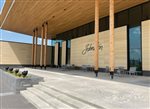NOTEBOOK: How Johnston’s new City Hall ties to the city’s past

KATHY A. BOLTEN Aug 10, 2021 | 6:38 pm
2 min read time
426 wordsBusiness Record Insider, Government Policy and Law, Real Estate and Development, The Insider NotebookBefore designs for Johnston’s new City Hall were prepared, architects at OPN Architects researched the history of the community that is located northwest of Des Moines.
They learned the area had deep ties to rail transportation. Specifically, the Inter-Urban Electric Railway that was established in 1907. The commuter and freight service ran from Carlisle to Perry, according to the Johnston Historical Society. Several transfer stations were located along the line’s route, including one in an area that is now part of the city of Johnston.
Transfer stations, typically small buildings, provided power to the Inter-Urban line, according to the historical society. The station northwest of Des Moines became known as Johnston Station, named after its station master, John Johnston.
“Architects like to tie the architecture of a building to the history of the community,” said David Wilwerding, Johnston’s community development director.
“We have a rail history since the Inter-Urban rail used to go just west of [the new City Hall], so this building has some uniqueness to its design.”
Tall wood columns are uniquely grouped in pairs around the building’s exterior overhangs. They are spaced at roughly 4 feet, 8 inches apart, the width of a typical rail line, Wilwerding said. The vertical height of each rectangular-shaped piece of limestone in the building’s facade is 19.5 inches, which is related to the typical railroad tie spacing
The 65-degree angle on the south edge of the community stage, the council dais layout and other subtle details around the new building are a nod to the original orientation of the railroad as it cut through Johnston, according to Joe Feldman of OPN Architects. “The tilt of overhang on the stage was used to project the sound into the green space and act as a symbolic gesture of the building opening up to the community,” he wrote.
Another feature of the building that relates to Johnston’s history is the limestone that is used throughout the structure, Wilwerding said. Portions of a historic fence that surrounds Camp Dodge, a military facility located at 7105 N.W. 70th Ave. in Johnston, are made with limestone.
When city officials updated the community’s comprehensive plan in 1998, “the council thought we were lacking identity,” Wilwerding said. “Now you see [city] monument signs all around the city that are made with limestone. It was a play off the limestone fence.
“That was an important historical tie between the new City Hall and the other limestone used throughout Johnston.”
Construction of the Johnston City Hall, located at 6221 Merle Hay Road, was completed earlier this year.










